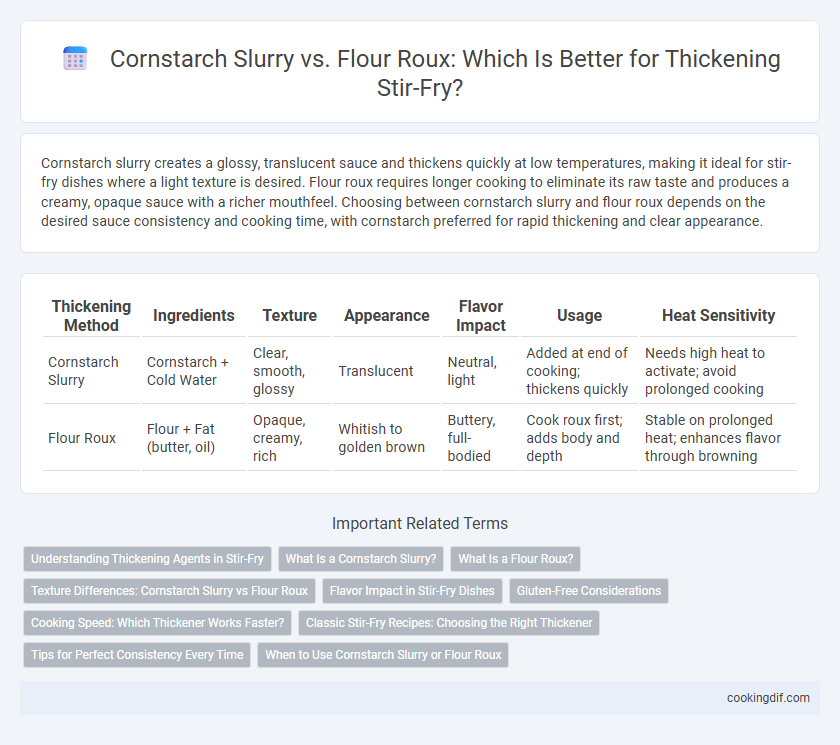Cornstarch slurry creates a glossy, translucent sauce and thickens quickly at low temperatures, making it ideal for stir-fry dishes where a light texture is desired. Flour roux requires longer cooking to eliminate its raw taste and produces a creamy, opaque sauce with a richer mouthfeel. Choosing between cornstarch slurry and flour roux depends on the desired sauce consistency and cooking time, with cornstarch preferred for rapid thickening and clear appearance.
Table of Comparison
| Thickening Method | Ingredients | Texture | Appearance | Flavor Impact | Usage | Heat Sensitivity |
|---|---|---|---|---|---|---|
| Cornstarch Slurry | Cornstarch + Cold Water | Clear, smooth, glossy | Translucent | Neutral, light | Added at end of cooking; thickens quickly | Needs high heat to activate; avoid prolonged cooking |
| Flour Roux | Flour + Fat (butter, oil) | Opaque, creamy, rich | Whitish to golden brown | Buttery, full-bodied | Cook roux first; adds body and depth | Stable on prolonged heat; enhances flavor through browning |
Understanding Thickening Agents in Stir-Fry
Cornstarch slurry and flour roux are essential thickening agents in stir-fry, each offering unique properties. Cornstarch slurry, made by mixing cornstarch with cold water, creates a translucent and glossy sauce that thickens quickly at high heat without altering flavor. Flour roux, a blend of flour and fat cooked together, provides a richer texture and deeper flavor but requires longer cooking time and may darken the sauce.
What Is a Cornstarch Slurry?
A cornstarch slurry is a mixture of cornstarch and cold water used to thicken stir-fry sauces quickly without altering the flavor. It creates a smooth, glossy texture that enhances the sauce's consistency, unlike a flour roux, which requires cooking fat and takes longer to develop. Cornstarch slurry is ideal for stir-fries because it activates rapidly at high heat, providing an immediate thickening effect.
What Is a Flour Roux?
A flour roux is a classic thickening agent made by cooking equal parts flour and fat, typically butter, to form a paste used in sauces and soups. In stir-frying, a roux provides a rich, velvety texture and a deeper flavor profile compared to cornstarch slurry, which thickens quickly but can result in a glossy, translucent finish. Roux requires longer cooking to eliminate the raw flour taste and develop its thickening power, making it ideal for hearty, complex dishes.
Texture Differences: Cornstarch Slurry vs Flour Roux
Cornstarch slurry creates a glossy, smooth texture with a light, translucent appearance in stir-fry sauces, offering a quick and clear thickening effect. In contrast, flour roux produces a denser, opaque sauce with a richer mouthfeel, often resulting in a slightly grainier texture due to the cooked flour. The choice between cornstarch slurry and flour roux significantly impacts the final sauce's visual appeal and consistency in stir-fry dishes.
Flavor Impact in Stir-Fry Dishes
Cornstarch slurry creates a glossy, transparent sauce that preserves the vibrant colors and fresh flavors of stir-fry dishes without adding any overt taste. Flour roux, on the other hand, imparts a richer, more buttery flavor and a slightly opaque appearance, which can deepen the overall taste profile but may mask some of the individual ingredient nuances. Choosing cornstarch slurry enhances the crispness and natural flavors of vegetables and proteins, while flour roux contributes a heartier mouthfeel and warmth to the finished dish.
Gluten-Free Considerations
Cornstarch slurry is a preferred thickening agent in stir-fry recipes for gluten-free diets due to its natural absence of gluten and smooth, translucent finish. Flour roux contains wheat flour, which can trigger gluten sensitivities and result in a cloudier sauce, making it less suitable for those with celiac disease or gluten intolerance. For reliable gluten-free cooking, cornstarch slurry provides an effective, allergen-safe alternative that maintains the desired sauce consistency.
Cooking Speed: Which Thickener Works Faster?
Cornstarch slurry thickens sauces almost instantly when added to hot liquids, making it ideal for quick stir-fry dishes that require rapid cooking. Flour roux takes longer to achieve desired thickness since it requires cooking the flour in fat before adding liquid, slowing down preparation. For faster thickening in stir-fries, cornstarch slurry is the preferred choice due to its immediate thickening action.
Classic Stir-Fry Recipes: Choosing the Right Thickener
Cornstarch slurry is the preferred thickener in classic stir-fry recipes due to its ability to create a glossy, smooth sauce without altering flavor, thickening quickly at high heat. Flour roux tends to add a heavier texture and requires longer cooking time, which can overwhelm the light, vibrant nature of stir-fry dishes. Using cornstarch slurry ensures precise consistency and preserves the fresh, crisp vegetables and tender proteins characteristic of authentic stir-fry meals.
Tips for Perfect Consistency Every Time
Use a cornstarch slurry for a clear, glossy finish and faster thickening in stir-fry sauces, mixing equal parts cornstarch and cold water before adding it gradually to hot liquids. Flour roux provides a richer texture but requires cooking the flour in fat to avoid a raw taste and longer cooking time to achieve desired thickness. Adjust slurry or roux quantities slowly while stirring continuously to achieve perfect consistency without lumps or over-thickening.
When to Use Cornstarch Slurry or Flour Roux
Cornstarch slurry is ideal for quickly thickening stir-fry sauces at the end of cooking, providing a clear, glossy finish that enhances the dish's presentation and texture. Flour roux works best for recipes requiring longer cooking times, developing a rich, opaque sauce with a smooth consistency ideal for simmered or braised dishes. Choose cornstarch for light, fast-thickened stir-fry sauces and flour roux for hearty, slow-cooked mixtures where depth of flavor and a creamy texture are desired.
Cornstarch slurry vs flour roux for thickening Infographic

 cookingdif.com
cookingdif.com